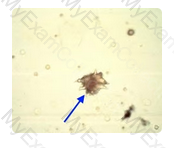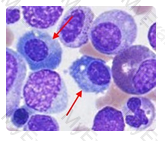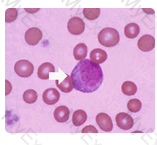Cholesterol levels do not fluctuate as triglycerides, fatty acids, lipoproteins, and chylomicrons do after an individual eats a meal. This is the reason that patients are told to fast; the laboratory needs a fasting sample to determine a lipid profile or panel which includes the latter four components.
Which of the following lipid tests is LEAST affected by the fasting status of the patient?
Interferon gamma serves various purposes in immunologic response, including the promotion of natural killer cell activity as well as decreased viral replication by using enzymes to decrease protein replication, both viral or host, inside of the cell.
The lymphokine most important for increased natural killer cell activity and decreased viral replication in cells is:
Valine substitutes for glutamic acid in the Beta 6 position to produce HbS.
To produce hemoglobin S, glutamic acid that is normally present in the sixth position on the beta globin chain is substituted with which of the following?
Blood collected in CPDA-1 may be stored at 1 - 6 oC for up to 35 days.
How long may blood be stored using CPDA-1 preservative prior to transfusion?
1. B
2. D
3. A
4. C
Red to Brown Urine: porphobilinogen, hematuria, myoglobinuria, etc.
Green: Food colorings; Increased carotene in the diet;
Pseudomonas aeruginosa infection
Yellow: bilirubin, bile pigments
White: phosphates, other crytals
Match urine color with substance that might have been responsible:
1. Phosphates
2. Bilirubin
3. Pseudomonas
4. Porphobilinogen
Which area of the laboratory is responsible for blood coagulation studies that test for the patient's ability to clot their blood?
Hemoglobin electrophoresis uses an electric field to separate hemoglobin molecules based on differences in net electrical charge. The rate of electrophoretic migration is also dependent on the ionic radius of the molecule, the viscosity of the solution through which it is migrating, the electrical field strength, temperature, and the type of supporting medium used.
Electrophoretic separation of hemoglobin fundamentally relies on:
The document designed to protect phlebotomists from contacting hepatitis is the:
These are tyrosine crystals

Urinalysis & Other Body Fluids
True or false? Cystine crystals are present on this slide.
Fatty casts contain refractile oval fat bodies or free fat droplets. They are derived from renal tubular cells, and may be seen in nephrotic syndrome.
Identify the urine sediment element:
Though automated extraction machines have many benefits over manual methods the costs are high and generally require a high throughput of samples in order to justify the costs.
Automated extraction has many benefits over the traditional manual methods. The most important benefit is that the nucleic acid isolated is constantly consistent. There is a reduced amount of manipulation with dramatically decreases the chance of cross contamination. Also, automated extraction machines are considered moderate complexity and can be performed by a wider variety of laboratory professionals.
All of the following are considered benefits of automated isolation and extraction equipment EXCEPT:
UA & Body Fluids
What is the identification of this crystal seen in a urine with an alkaline pH?

Which of the following is a selective media recommended for the isolation of Clostridium difficile?
A beam splitter is employed in a dual beam spectrophotometer.
Which of the following is not a component of a basic single beam spectrophotometer:
A test with high specificity accurately detects the absence of disease. The more specific a test is, the fewer false-positive results will occur. A test with high sensitivity accurately identifies the presence of disease. The more sensitive a test, the fewer false-negative results it produces. In the case stated in this question, the immunoassay has high specificity, so it has few false-positives and will accurately detect those individuals who do not have the disease or condition that is being tested for. However, the test has low sensitivity, so it may not identify all individuals who actually have the disease; it may produce many false-negative results.
The accuracy of an immunoassay is its ability to discriminate between results that are true positives and results that are true negatives. Two parameters of test accuracy are specificity and sensitivity. Which of these statements apply to an immunoassay with high specificity, but low sensitivity?
Creatinine clearance tests are utilized to estimate the glomerular function of the kidney. The creatitine clearance calculation is defined as the volume of plasma that is cleared of creatinine by the kidney per unit of time and uses the following formula:
creatinine clearance = Urine creatinine conc x Volume / Plamsa creatinine conc
Creatinine clearance measurements have a recommended specimen requirement = 24-hour urine collection.
Which of the following tests would be useful in the assessment of glomerular filtration:
Immunology
The immunoglobulin molecule is made up of both heavy and light chains - the light chains can be comprised of which of the following:
FFP that has been thawed at 30 - 37oC and maintained at 1 - 6oC must be transfused within 24 hours. In contrast, "Thawed Plasma" can be used for up to 5 days as a replacement therapy for patients requiring stable clotting factors. Keep in mind that these are two different component types and you are asked about FFP.
Blood Bank
FFP that has been thawed at 30 - 37oC and maintained at 1 - 6oC must be transfused within ___________ after it has been thawed.
The recommended order of draw for a complete blood count (CBC), prothrombin time, and cholesterol is:
HCG levels rise rapidly during the first trimester, then the levels start to decline around week 16. The hCG levels slowly decrease and can level off during the remainder of the pregnancy.
The following BEST describes serum hCG levels during pregnancy:
Some elderly individuals can have poor dietary habits which can lead to decreased nutrient absorption, including zinc.
A zinc deficiency in the elderly is often caused by:
Glycoprotein IIb/IIIa is integral in the process of platelet aggregation as well as clot retraction.
A defective clot retraction might be caused by which one of these?
Oxalate, EDTA, and citrate are anticoagulants that inhibit clot formation.
Which of the following blood additives is most useful for serum collection:
1. B
2. C
3. A
Granular casts are composed of plasma protein aggregates and cellular remnants. Granular casts appear as cylinders of coarse, or fine, highly refractive particles.
Broad casts or "renal failure' casts are formed in the collecting ducts as the result of urinary stasis and are two to six times the size of other types of casts. Any type of cast can be a broad cast. Broad casts are typically seen in patients with advanced renal failure.
Hyaline casts, the type most commonly seen in urine sediment, have a refractive index similar to the urine in which they are suspended. For this reason, hyaline casts will appear almost invisible under brightfield microscopy, but are easily of seen by phase-contrast microscopy.
Match the following descriptions of casts with their appropriate name:
1. Casts with highly refractive particles
2. "Renal failure" cast
3. Low refractive index
India ink can aid in the visualization of the polysacchride capsules of yeast such as Cryptococcus neoformans.
Micro
India Ink is used to:
Alkaline over acid, or K/A, in TSI reactions is associated with the fermatation of glucose alone and the utilization of peptone.
Which of the following sugars has been fermented by a gram-negative rod that has produced an alkaline slant and an acid butt on triple sugar iron agar (TSI).?
The cells are plasma cells. They are larger than normal small lymphocytes with more abundant cytoplasm. The cytoplasm is more basophilic than the cytoplasm of a normal lymphocyte and a well-defined perinuclear halo (clearing in the golgi area) is noticeable. The nucleus is eccentrically placed. Plasma cells are counted in a separate category on a bone marrow differential.

Hematogones are blast-like cells that are more mature than lymphoblasts. They are usually tallied with lymphocytes when performing a bone marrow differential.
What are the cells that are indicated by the red arrows in the image on the right?
According to OSHA, Hazard Communication 1910.1200 has the purpose of ensuring that the hazards of all chemicals produced or imported are evaluated, and that information concerning their hazards is transmitted to employers and employees.
Also known as the "Right To Know Law," which one of the following OSHA regulations first dealt with specific information related to the contents of chemicals used in the workplace?
An international, nonprofit organization that establishes standards of best current practice for clinical laboratories is
AABB Standards do not require a DAT, autologous control, or a minor crossmatch for pretransfusion testing.
Essential components of compatibility testing include all of the following except :
Chemistry
Estrogen and progesterone markers are most commonly used to provide prognostic information about:
Blood Bank; Immunology
Which of the following best describes the primary function of antibodies:
Gluconeogenesis is the formation of glucose from noncarbohydrates when carbohydrate intake is absent, a fasting state. The hormone cortisol along with glucagon and epinephrine all stimulate this metabolic pathway. Insulin; however, inhibits this pathway and is therefore the correct answer.
Which of the following hormones inhibits gluconeogenesis, the formation of glucose from noncarbohydrate sources such as amino acids, glycerol, and fatty acids?
The membranes of ion selective electrodes will determine which analyte is measured by the electrode.
Chemistry
The selectivity of an ion-selective electrode is determined by the:
Which of the following Rh antigens is found the highest frequency in the Caucasian population:
The cell shown in this image is a myelocyte. Myelocytes typically have an eccentric nucleus with cytoplasm similar to a mature neutrophils with a slightly bluer tint due to the cell's immaturity.

Myelocytes have both primary and secondary granules present in the cytoplasm. The nucleus is less mature and therefore has a loose chromatin clumping pattern.
Identify the cell in this illustration indicated by the arrow:
Elevation in conjugated bilirubin is most likely to be found in which of the following conditions:
In which of the following laboratory situations is a verbal report permissible?
Root cause analysis (RCA) is a structured study that determines the underlying causes of adverse events. RCA focuses on systems, processes, and common causes that were involved in the adverse event. It then determines ways to prevent recurrence by identifying potential improvements in systems and processes that should decrease the likelihood of repeating the event.
Failure mode and effect analysis (FMEA) is used to evaluate a process prior to its implementation. Its purpose is to identify ways in which a process might possibly fail with the goal being to eliminate or reduce the likelihood of such a failure.
Monitoring quality indicators is important in the maintenance of quality health care. Quality indicators should be identified to prevent medical errors from occurring or to prevent the recurrence of a quality issue. However, it is not the method that is used to evaluate an adverse event after it has occurred.
A medical record audit may be a part of a root cause analysis.
A medical event occurs that results in serious injury to a patient. All systems, processes, and common causes that were involved in the adverse event should be evaluated. A method that can be implemented to effectively study the underlying causes is known as:
Medical Technology is the profession concerned with performing laboratory analyses
A zone of inhibition is the area around an antibiotic-infused paper disk that does not show any bacterial growth. The antibiotic impregnated on the disk will diffuse into the agar in the area surrounding the disk. If the bacteria are sensitive to the antibiotic, they cannot grow near the disk. The size of the zone is proportional to how sensitive the organism is. If the organism is resistant to the antibiotic, it will grow very closely to the disk.
The size of the zone of suppressed growth on a sensitivity plate using sensitivity disks is referred to as the zone of:
In an evacuated tube, blood flow into the tube depends on:
Question options:
Which of the following is NOT part of the magnification system of the microscope?
The FTA-ABS is used to confirm that a positive non-treponemal test like RPR is not the result of a biological false positive, which occur in about 1 to 10 percent of the population.
A positive RPR test and a negative FTA-ABS test is most likely the result of:
Blood Bank
What other component(s) can be shipped together with Fresh Frozen Plasma (FFP)?
The most likely causes of delayed hemolytic reactions are Kidd system antibodies. Both jka and jkb are often responsible for delayed hemolytic transfusion reactions.
Blood Bank
Delayed hemolytic transfusion reactions are usually caused by antibodies directed against what blood group system?
The MCV is indicative of microcytosis with MCV=<80fL. The RDW is within normal limits and indicative of a homogenous cell population.
If the MCV was >100 fL, this would be indicative of macrocytosis. An RDW that was outside of normal limits would be indicative of a heterogenous cell population.
An 18 year old female has a CBC as part of a routine physical exam. The following results were obtained and the physician determines she is anemic. After reviewing her CBC results shown below, which of the following would be an appropriate description of the anemia?
White blood cells (WBC): 5.6 x 10^9/L (RR:4.0-10.0 x 10^9/L)
Red blood cells (RBC): 3.7 x 10^12/L (RR: 4.2-5.9 x 10^12/L)
Hemoglobin: 9.9 g/dL (RR:12-16 g/dL)
Hematocrit: 28% (RR: 37-48%)
MCV: 75 fL (80-100 fL)
RDW-CV: 14% (RR: 11.0-15.0%)
Bacterial contamination can manifest itself in several ways including: the presence of clots, darker purple-black color of blood unit, unit can appear cloudy, hemolysis may be present.
During routine inspection, a unit of unexpired blood was noticed to have a black color with numerous small clots. What is the likely cause for this observation?
Skeletal deformations result from the increased erythropoiesis that occurs in beta thalassemia major. Children with beta thalassemia intermedia may demonstrate some facial bone deformity, however this is not common. Beta thalassemia minor rarely causes any physical signs or symptoms and beta thalassemia minima is completely asymptomatic.
Skeletal deformations are most commonly present in which of the following beta thalassemias?
A patient has a WBC count of 4,000/mm3, a platelet estimation with 3 bizarre platelets/oil immersion field, hemoglobin, hematocrit, red cell count and indice values are within normal limits. Blue-staining inclusions are seen in the cytoplasm of many neutrophils. These inclusions fit the description of:
Synovial fluid is actually quite viscous and does not have the same consistency as plasma. The reason for its thicker consistency is to provide cushion and reduce friction between the articular cartilage of synovial joints during movement.
Urinalysis & Other Body Fluids
All of the statements below about synovial fluid are true EXCEPT:
Thrombocytes, or platelets, are of course involved with hemostasis, not immunity.
Immunology
Which of the following would not be considered a part of the body's cellular immune system:
Troponin is a very specific biomarker that is released during cardiac injury or stress. CK is found not only in cardiac tissue, but also in muscle and brain tissue. LD levels can be elevated in cardiac events, tissue breakdown, and hemolysis. Myoglobin is elevated when muscle tissue is damaged and is not specific for the heart muscle.
Chemistry
Which one of the following is the MOST specific biochemical marker of myocardial infarction?
Patient's with diseases such as congential hemolytic anemias and aplastic anemias require frequent transfusions. Each unit of red cells contains 225 mg of iron, which puts these patients at risk for iron overload.
Blood Bank
Patients with diseases that require chronic transfusions are at risk for iron overload.
Secondary granules, also known as specific granules first appear in the myelocyte stage next to the nucleus. In neutrophils this is termed the "dawn of neutrophilia".
What is one of the main characteristics of secondary granules in the neutrophilic granulocyte cytoplasm?
High triglycerides may be caused by disorders such as type 2 diabetes, hypothyroidism, Cushing's sydnrome, liver disease, uremia, dysglobulinemia, nephrotic syndrome, and alcoholism can cause hypertriglyceridemia.
A 46-year old known alcoholic with liver damage is brought in the ER unconscious. One would expect his lipid values to be affected in what way?
Personal protective equipment (PPE) should be put on in the following order:
Mrs. Jones, a diabetic, is admitted to the hospital on November 25th. It appears that she has had an AMI but did not feel the severe chest pain because of diabetic neuropathy. She has not felt well since November 20th and her physician believes she possibly had an AMI on November 20th.
Assuming that the infarct was uncomplicated, which of the following cardiac biomarkers would most likely still be elevated and would assist in an AMI diagnosis?
Which of the following disorders is characterized by increased production of chloride in sweat?
Multiple myeloma
The morphologic characteristic(s) associated with the Chediak-Higashi syndrome is (are):
Beta-thalassemia major, also known as Cooley's anemia, has inherited two genes for beta thalassemia without a normal beta-chain gene. This disease is assoicated with a marked deficiency in beta chain production and in the production of normal Hb A. These patients exhibit increased amounts of iron due to the mutliple transfusions that keep them alive. There is also a striking increase in hemoglobin F and an elevation in hemoglobin A2.
Hematology
A 5-year-old African American child with hepato-splenomegaly and skeletal abnormalities has the following lab results:
WBC = 4,800/cu.mm
20 NRBC/100 WBC
RBC = 2.70 X 106
HGB = 6.2 g/dL
Many target cells
Marked hypochromasia, anisocytosis & poikilocytosis
Serum Iron = 200 µg/dL (elevated)
Sickle Solubility = negative
Hemoglobin F = elevated
What is the PROBABLE cause of these findings?
The deposition of plaques containing cholesterol and lipids on the innermost layer of the walls of large and medium-sized arteries is the defintion of atherosclerosis.
Arteriosclerosis is a more general term that describes a thickening and loss of elasticity of the walls of the arteries (hardening of the arteries). Atherosclerosis is a type of arteriosclerosis but is not synonymous with it.
Atherosclerosis is not the most common outcome for risk marker studies because it can be hard to measure. Infarcts, cardiac procedures, death, and 'events' are more common. Most humans have visible or measureable atherosclerosis by early middle age.
Chemistry
Which of the following is true concerning atherosclerosis?
Glucagon and epinephrine promote glycogenolysis, conversion of glycogen to glucose, which increases plasma glucose.
Cortisol along with glucagon increases gluconeogenesis, formation of glucose from noncarbohydrates which also raises plasma glucose concentration.
Chem
Which of the following hormones increases plasma glucose concentration by converting glycogen to glucose? Please select all correct answers
All of the following have been an inspection deficiency for CLIA-approved laboratories except:
Bone marrow biopsies are helpful diagnostic tools in:
Evaluation of anemia and thrombocytopenia
Evaluation of cytopenias
Diagnosing leukemias
Can be part of evaluation for FUO
Bone marrow biopsies are NOT used as screens for hematologic issues during routine check-ups.
Hematology
In which of the following situations would a bone marrow aspirate and biopsy possibly be used as an aid for diagnosis? (Select all that apply)
Transfusion of red cells of any ABO type other than O to a group O patient is of course likely to cause a hemolytic transfusion reaction.
Which of the following types of packed RBCs could be transfused to a group O patient:
The negative antigen frequencies are used in the formula below to determine the percent of type-specific units that would be compatible for the patient. Negative antigen frequencies are determined by subtracting the percent antigen frequency from 100%. The negative antigen frequency for K in this case is .91 (1.00 - .09) and the negative antigen frequency for Fya is .34 (1.00 - .66).
% compatible units available = 100 x (Neg frequency #1 x Neg frequency #2...)
For this case, the calculation is:
% compatible units available = 100 x (0.91 x 0.34) = 30.94 or 31%
If the antigen frequencies for K = 0.09 and Fya = 0.66, what percent of type-specific units would be compatible for a patient with anti-K and anti-Fya?
The electrolyte panel consists of potassium, sodium, chloride, carbon dioxide. These analytes are also typically ordered within other panels as well, including the basic metabolic and complete metabolic panels.
An electrolyte panel (lytes, chem-4) consists of:
Hemoglobin H is a tetramer made of four beta globin chains. Hemoglobin H occurs when there is very limited alpha chain availability used to make normal hemoglobin A. Hemoglobin H forms in those affected with alpha thalassemia major as well as in people with the combination of two-gene deletion alpha thalassemia and hemoglobin Constant Spring.
Hematology
Which of the following combination of globin chains comprise Hemoglobin H?
The indole (modified Kovacs' reagent) is used to assess the ability of certain bacteria to produce indole by the deamination of tryptophan. Indole reacts with aldehyde in the Kovac's reagent to produce a red color. An alcoholic layer holds the red color as a ring at the top of the tube used for the idole test.
If a bacteria produces the enzyme tryptophanase to break down the amino acid tryptophan, which of the following tests will be positive with Kovac's reagent?

